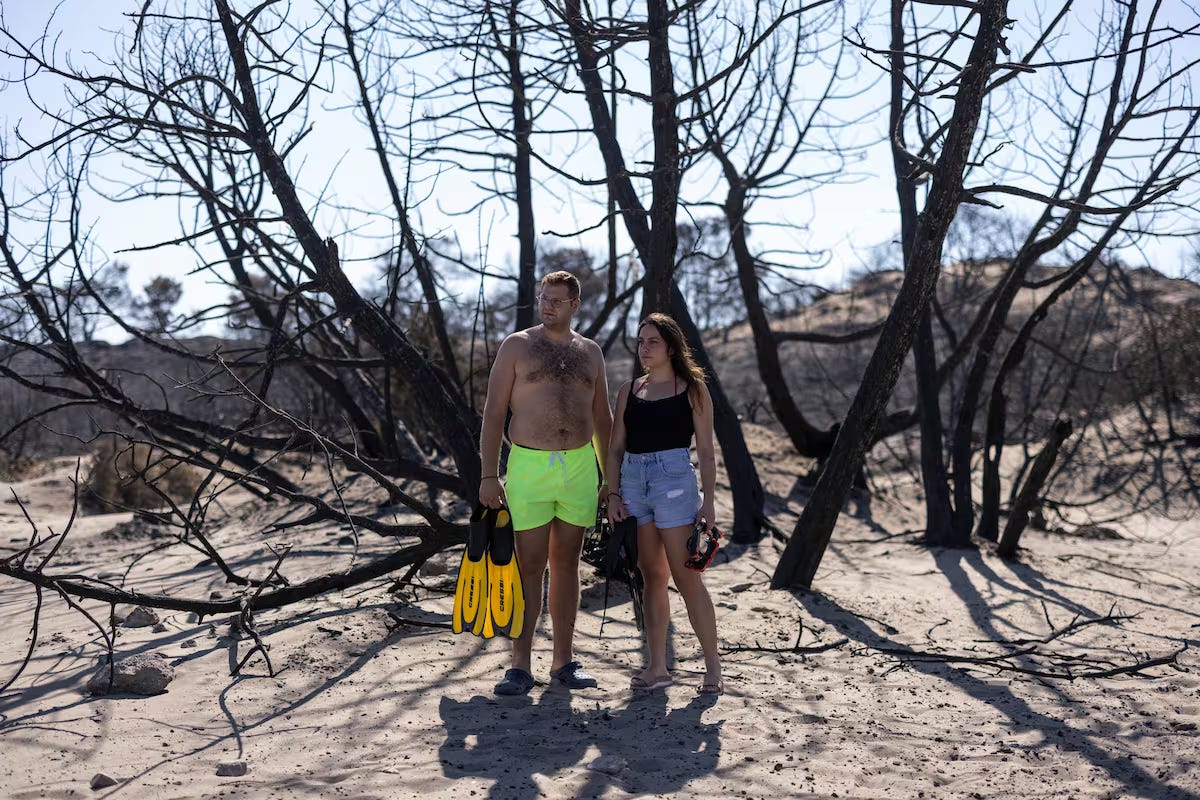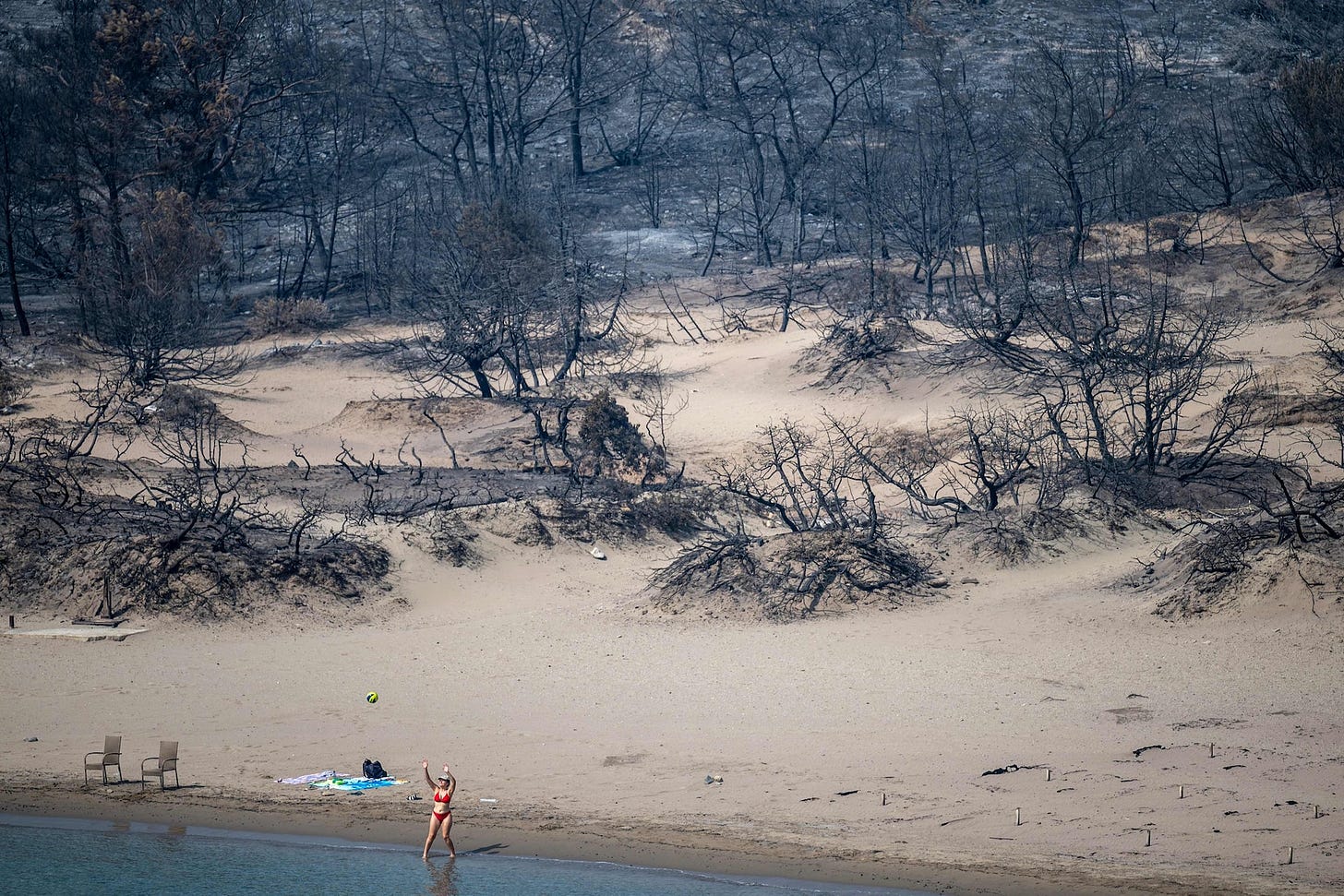If This Summer is Anything Like the Last
If this summer is anything like the last, the climate crisis will destroy more norms, we will gasp, then forget, and photographers will continue to skewer our denial.

Last summer, scorching temperatures shattered heat records in the Southwest and Europe. Lahaina, the historic Hawaiian resort, was destroyed, and the Arctic saw an unthinkable 100-degree temperature, 30 degrees above average. But as the world burned, a peculiar dichotomy emerged in the visual narrative of climate disaster. On one hand, photojournalists captured the unflinching reality of a planet in crisis, their images a testament to the devastating demise. Conversely, a more provocative thread of irony and sarcasm wove through the visual landscape, hinting at a more profound disconnect between the reality we face and the reality we choose to see.
With another summer upon us, we are in far worse shape for failing to process the last one’s catastrophic slide. What made the previous season more shocking than ever was how the worst climate events occurred where people seek refuge and escape. You would think Mother Nature fixing a death ray on the world’s most iconic vacation spots—especially where the one percent go to play—would sound a deafening alarm. But instead, the doomsday clock ticks on.
Not since Covid stranded sick tourists on cruise liners in Spring 2020 had the home page so blithely intruded on the travel section. In contrast to previous seasons, when holiday shock and awe came from images of threatened summer playgrounds or danger on the horizon, last year hastened the destruction of idyllic getaways in real time.

Take this photo from the island of Rhodes. With an explosive blaze threatening to level an Aegean resort, the new abnormal found tourists joining the bucket line.

Though horrifying, the photos of the destruction of Lahaina's paradise in Maui were not unfamiliar. Conjuring images of the sinking of Atlantis or island myths about ancestors transformed into sea creatures, we saw residents and tourists escaping the inferno by throwing themselves into the sea.

The duration and intensity of the record-breaking heatwave that gripped the American Southwest were as mind-boggling as they were life-threatening. On the July day above, the temperature in Las Vegas reached a record high of 117°F, making it one of the hottest days in the city's history, while temperatures in Death Valley reached 134°F.
The man’s obvious duress amidst the sea of traffic lights shatters the illusion of Sin City and the desert oasis fantasy.

And what about the pain and suffering at the World Scout Jamboree in South Korea, which is typically the dream of a lifetime for international youth? Thankfully, the Jamboree had its own hospital. The conclave eventually sent its 39,000 participants home early as a heatwave, and a lack of natural shade at the campsite caused hundreds to fall ill.
Canaries in the Carbon Field
Photojournalists have been turning out the most informative and gripping documentation of climate disasters. But, with the public steeped in denial or frozen in fear, visual reporters have also been turning our complicity into so much commentary on the denial itself. And what better tools for going there than irony or satire? If the facts and scenes of our leisurely demise don’t raise awareness, maybe gallows humor will. At least, it will leave a record that we should have known better.

In this eye-catching image, a woman in Beijing shields her face from the blistering sun by covering her head with her shirt. As the government orders employers to halt outdoor work due to the 104°F forecast, this scene conjures mindlessness or burying our heads in the sand.

Channeling photographer Martin Parr’s tongue-in-cheek, this photo by Fabrizio Villa dials up the mundanity as a counterpoint to the conflagration outside. In the face of the wildfires that terrorized Catania on the eastern coast of Sicily in August, the relief workers with the drinks look painfully awkward. The three women are nonplussed. The figure in the center calls out to nobody. And the focus on that fan is deadpan.

This was one of the summer's most unsettling images. Call it playing beachball with death, this picture from a fire-riven Rhodes captures civilization and tourism beyond the pale.
Waterplay has been standard fare as long as news photographers have been documenting heat waves. But scenes of people frolicking at swimming pools, watering holes, or public fountains too often dismiss the existential threat of global warming. To the extent the media continues to blur the crisis with the everyday, more news photographers are infusing these images with an edginess to call out "business as usual."

Yes, this one from Rome is another picture of a missing head. But with heat waves becoming unbearable and worse ahead, the image is a bit more ambiguous than the woman lost in her shirt. Sure, the photo largely conjures relief, but the thoroughness of this submersion, combined with the effect of the frozen moment, also toys with drowning.

This photo from Jerusalem by Dedi Hayun pushes the ambiguity even further. With three of the four bodies lying prone on the pavement, the standard image of romping in the fountain takes on an odd, almost ominous tone. It's also quite the commentary on climate denial when the default approach to the crisis is to play till you drop. One might even call it prophetic.
Thank you for visiting Reading the Pictures, dedicated to analyzing news photography and media images. This post is public so feel free to share it.
To receive new posts and support our work, consider becoming a free or paid subscriber. Because we are a non-profit, your subscription is tax deductible.


